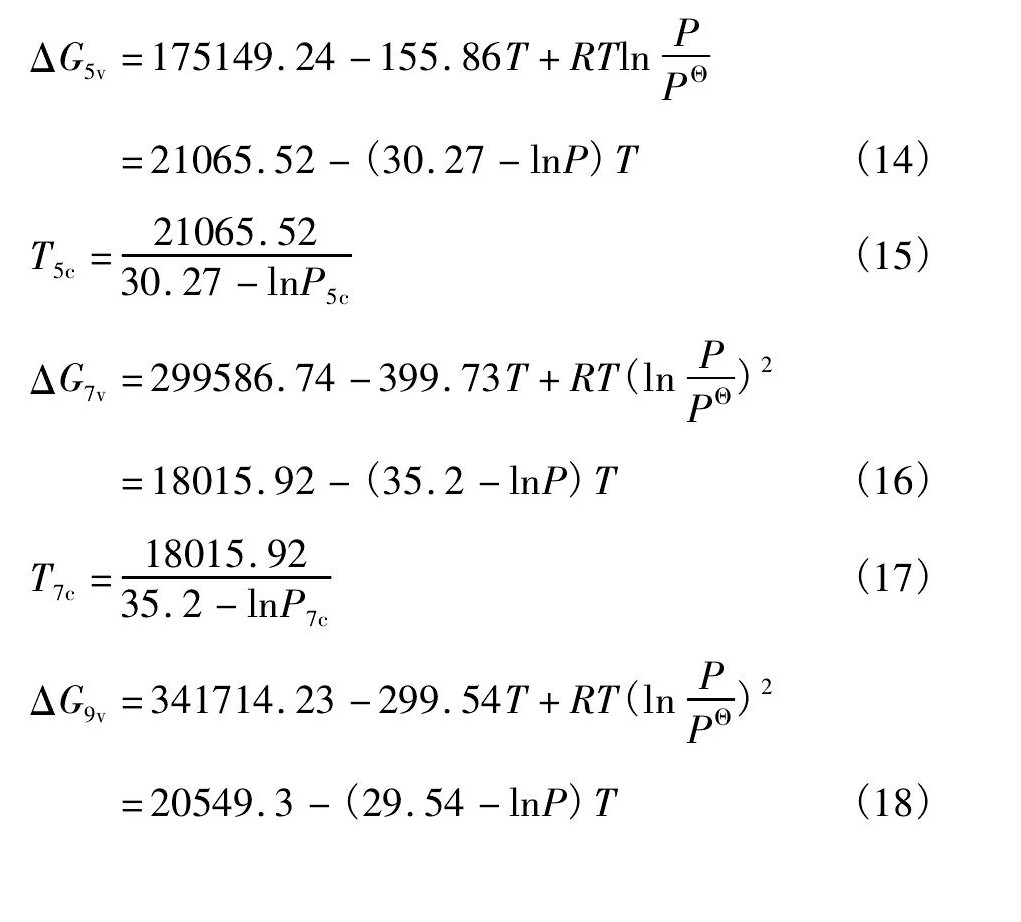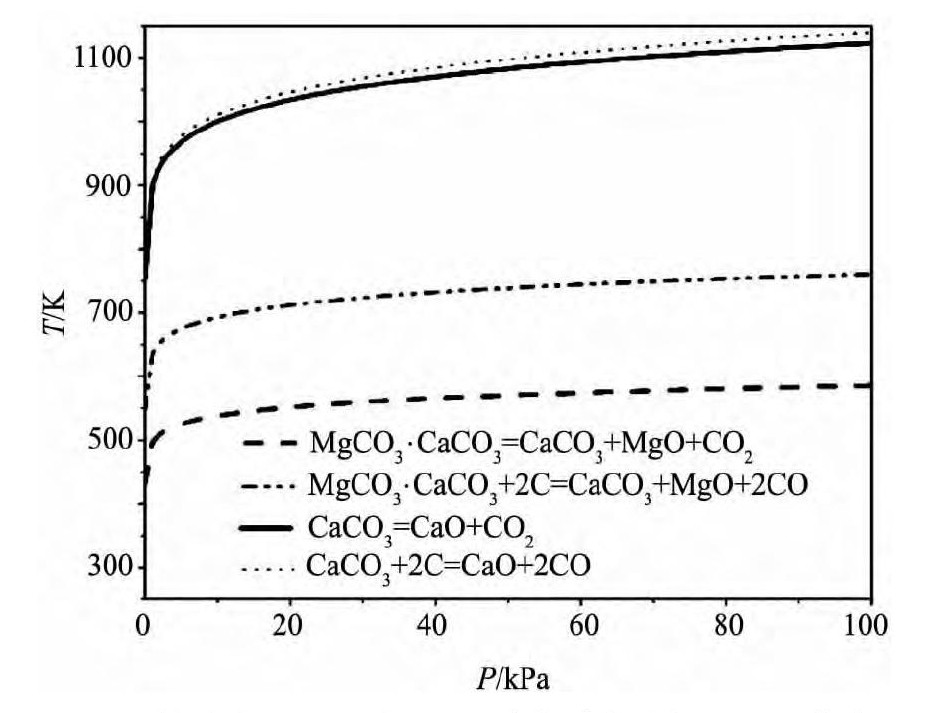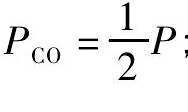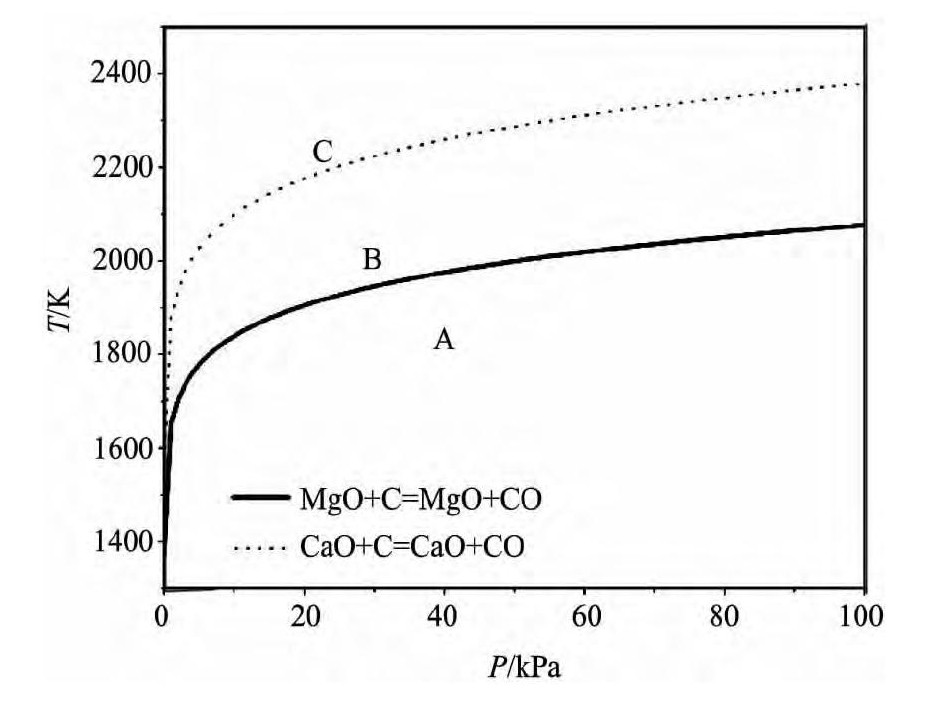稀有金属 2014,38(02),306-311 DOI:10.13373/j.cnki.cjrm.2014.02.020
白云石-碳体系热分解及热还原的热力学分析
陈杰 胡发平 潘佳 马欣 彭晓东 谢卫东
重庆大学材料科学与工程学院
重庆大学国家镁合金材料工程技术研究中心
摘 要:
分析了以白云石制备金属镁的现有技术中, 热分解、热还原等环节资源能源利用不充分、环境载荷重、生产效率低等问题, 提出了白云石与碳的混合物一次装料后先后完成热分解和热还原, 获得金属镁、钙的新方法, 计算分析了单纯白云石和白云石-碳体系常压热分解、真空热分解的Gibbs自由能和临界条件, 以及煅烧白云石碳热还原制备金属镁及金属钙的Gibbs自由能和临界条件。结果表明, 在较高的反应温度、较低的系统气压 (真空度) 下, 白云石-碳体系热分解反应、煅烧白云石碳热还原反应均具备热力学可行性;白云石-碳体系的临界热分解温度略高于单纯白云石热分解温度, 但最高临界分解温度仅增加17.04 K, 且副产物CO的利用价值高;真空度可显著减小白云石-碳体系热分解和煅烧白云石碳热还原反应的Gibbs自由能, 显著降低热分解、热还原临界温度, 当系统真空度为10 Pa时, 最高临界热分解温度、MgO临界还原温度、CaO临界还原温度分别为754.38, 1353.95, 1531.41 K, 分别较常压大气环境中低369.38, 765.26, 897.26 K;碳热还原MgO, CaO的临界反应条件差异较大, 可通过调控适宜的温度、真空度及其组合, 创造只获得金属镁、先获得金属镁再获得金属钙、同时获得金属镁和金属钙等反应条件, 实现白云石资源的合理、高效利用。
关键词:
白云石;热力学;Gibbs自由能;真空;碳;
中图分类号: TF822;TF827.1
作者简介:陈杰 (1987-) , 男, 安徽阜阳人, 硕士研究生, 研究方向:轻合金新材料及其制备与成型;E-mail:cjslf919@hotmail.com;;谢卫东, 教授;电话:023-65127304;E-mail:wdxie@cqu.edu.cn;
收稿日期:2013-07-25
基金:国家科技部国际科技合作计划项目 (2010DFR50010);国家大学生创新性实验计划项目 (1210611007) 资助;
Thermodynamics Analysis for Thermal Decomposition and Thermal Reduction of Dolomite-Carbon Hybrid System
Chen Jie Hu Faping Pan Jia Ma Xin Peng Xiaodong Xie Weidong
School of Materials Science and Engineering, Chongqing University
National Engineering Research Center for Magnesium Alloys, Chongqing University
Abstract:
The thermal decomposition and thermal reduction procedures of present magnesium manufacture technique, based on dolomite minerals, had numerous issues on the depletion of resource and energy, the heavy environmental loading and the low production efficiency. A new method of preparing metallic magnesium and calcium was proposed, by putting dolomite-carbon hybrids into a vacuum pot where the thermal decomposition and thermal reductions of hybrids were completed sequentially in once loading. The Gibbs free energy and critical reaction conditions of sole dolomite's and dolomite-carbon hybrids' decomposition at atmospheric pressure and under vacuum condition were calculated and analyzed, and that of preparing metallic magnesium and calcium through carbothermal reduction of calcined dolomite was calculated and analyzed as well. The results indicated that the thermal decomposition reaction of dolomite-carbon hybrids and the thermal reduction reaction of calcined dolomite under higher reaction temperature and lower system gas pressure ( the vacuum degree) were feasible from the perspective of thermodynamics. The critical thermal decomposition reaction temperature of dolomite-carbon hybrids was slightly higher than that of the sole dolomite thermal decomposition reaction, however, the highest criticaldecomposition temperature just increased by 17. 04 K and the by-product CO had high utilization value. Besides, the vacuum degree could largely diminish the Gibbs free energy of dolomite-carbon hybrids' thermal decomposition reaction and calcined dolomite' carbothermal reduction reaction; when the system vacuum degree was 10 Pa, the highest critical temperature of decomposition reaction, the critical reduction temperature of MgO and CaO, was 754. 38, 1353. 95, 1531. 41 K, respectively, compared with that at atmospheric pressure, which was lowered by 369. 38, 765. 26, 897. 26 K. In addition, the difference between the critical reduction temperature of carbothermal reduction MgO and CaO was quite great, and the preparing conditions could be controlled to produce metallic magnesium only, the metallic magnesium first and the metallic calcium second, and the metallic magnesium and the metallic calcium simultaneously, respectively, and could achieve the goals of utilizing the dolomite mineral reasonably and efficiently, by regulating the reaction temperature, vacuum degree and their combinations properly.
Keyword:
dolomite; thermodynamics; Gibbs free energy; vacuum; carbon;
Received: 2013-07-25
白云石是Mg CO3和Ca CO3的复盐, 分子式为Mg CO3·Ca CO3, 理论上含有Mg O 21. 8% , Ca O30. 4% 和CO248. 8% , 广泛应用于耐火材料、陶瓷、建材和制药等工业中, 同时也是最重要的炼镁原材料[1 - 3]。
采用白云石炼镁时, 通常需先通过高温热分解, 获得主成分为Mg O, Ca O的煅白, 再经热还原获得金属镁。
常规的白云石热分解一般在常压、1350 ~1550 K下进行, 每生产1000 kg煅白需消耗约4000 kg标准煤, 存在温度高、设备耗损大、能耗高等问题[4 - 6]。
目前, 热还原制镁最常用的方法是基于硅热还原的“皮江法”, 历经70 余年的发展, 该法已得到大面积应用, 全球绝大部分的原镁均通过该方法制造。同时, 该方法也存在一些不足, 如: 还原剂硅铁成本高, 煅白中的Ca O利用不充分, 副产渣量大且难于处置, 反应温度高、时间长、能耗高等[7 - 8]。
20 世纪30 年代Hausgirg提出了碳热还原制镁法, 该法在还原剂成本、渣量、资源能源利用等方面优势显著。我国戴永年等学者论证了碳热还原Mg O的理论可行性, 并得到一定的实验验证[9]。
采用白云石制镁, 无论硅热还原法还是碳热还原法, 一般均先高温热分解获得煅白, 待其冷却后, 经配料、混匀、压团、装炉、还原后获得金属镁。期间的“加热—冷却—再加热”的环节使得工艺流程冗长, 热能利用很不充分[10 - 12]。
为探寻资源、能源高效利用、环境负荷小、综合技术经济性能好的制镁 ( 及钙) 新途径, 本文提出将白云石与碳的混合物一次装料后, 在真空中先后完成白云石热分解为煅白, 以及煅白热还原为金属镁、钙的新方法, 重点研究白云石热分解及热还原的热力学规律, 探讨碳、真空度及其组合对热分解和热还原的影响, 为发展白云石制备金属镁、钙的短流程新技术、新工艺积淀基础。
1白云石和白云石-碳体系常压热分解热力学
白云石Mg CO3·Ca CO3的热分解产物为Mg O, Ca O, CO2, 其分解反应历程一直存在争议。目前, 认可度较高的为两步分解: 第一步, Mg CO3·Ca CO3分解为Ca CO3, Mg O和CO2; 第二步, Ca CO3分解为Ca O和CO2[13 - 17]。
白云石热分解第一步反应方程式为:

采用物质Gibbs自由能函数法ΔGΘT=ΔHΘT0-TΔΦT计算化学反应的标准Gibbs自由能。以298 K为参考温度, 则有ΔGΘT=ΔHΘ298-TΔΦ'T, 查找叶大伦等编著的《实用无机物热力学数据手册》, 将各物质的热力学性质数据并带入, 可得到298 K~T温度区间的一系列T-ΔGΘ数值对应值, 使用回归分析法可整理成标准Gibbs自由能二项式[18]。
那么, 反应 (1) 的标准Gibbs自由能为:

反应 ( 1) 在常压大气环境中进行时, 根据Van't Hoff方程, 其Gibbs自由能为:

式中PCO2为反应系统中CO2的分压。PΘ为标准大气压。
将反应进行地的大气压力近似为标准大气压后, 有:

第二步反应的反应式为:

采用与式 ( 2) ~ ( 4) 相似的方法, 反应 ( 5) 在常压大气环境中的Gibbs自由能为:

在白云石与碳一次装料后先后完成热分解和热还原的新方法中, 热分解阶段即存在碳此时的热分解为白云石-碳体系热分解。其第一步反应方程式为:

采用与式 ( 2) ~ ( 4) 相似的方法, 并经计算, 反应 ( 7) 在常压大气环境中的Gibbs自由能为:

白云石-碳体系热分解第二步反应方程式为:

采用与式 ( 2) ~ ( 4) 相似的方法, 并经计算, 其在常压大气环境中的Gibbs自由能为:

对比分析反应 ( 1) , ( 5) , ( 7) , ( 9) 的 ΔG - T关系式 ( 4) , ( 6) , ( 8) , ( 10) , 表明: 4 个反应的ΔG均随温度T升高而降低, 对应于 ΔG = 0, 4 个反应的临界分解温度分别为586. 09, 1123. 76, 760. 89 和1140. 80 K; 只要高于这些临界温度, 相应的反应即可正向进行。碳的引入, 使得白云石第一步、第二步热分解反应的临界温度分别增高174. 80 和17. 04 K, 最高分解温度增加值甚微。而且, 白云石-碳体系热分解副产物CO的利用价值较单纯白云石热分解的CO2高。
2白云石和白云石-碳体系真空热分解热力学
反应 ( 1) 在真空中进行时, 根据Van't Hoff方程, 其Gibbs自由能为:

由于反应系统中的气体几乎只有CO2, PCO2≈P, ( P为反应系统的绝对真空度) , 于是有:

当反应 ( 1) 处于平衡状态时, ΔG1v= 0, 经推导可得,

式中T1c, P1c分别对应为反应 ( 1) 处于平衡状态时的温度和真空度, 也是反应 ( 1) 的临界温度和临界真空度。
采用与式 ( 12) ~ ( 13) 相似的方法, 可得到真空中进行的反应 ( 5) , ( 7) , ( 9) 的 ΔGv-T关系式和Tc-Pc关系式:


图1 为反应 ( 1) , ( 5) , ( 7) , ( 9) 在真空中进行时的Tc-Pc曲线。从中可见, 4 个反应的临界分解温度Tc均随真空度Pc的减小而降低, 而且, 在Pc小于大约1000 Pa后, 随着Pc减小, Tc降幅较大。当真空度为工业上很容易实现的1000 Pa时, 4个反应的Tc较单纯白云石在常压大气环境中热分解分别降低88. 05, 222. 40, - 50. 54 和215. 89 K;当真空度为“皮江法”中常用的真空度相近的10 Pa时, 4 个反应的Tc比常压大气环境中单纯白云石热分解分别低153. 15, 370. 78, 38. 56 和369. 38K, 表明真空度对白云石热分解有益, 尤其对降低白云石第二阶段热分解反应的临界温度 ( 最高临界热分解温度) 益处显著。
综上可见, 从热力学角度, 较高的真空度环境有利于单纯白云石和白云石-碳体系热分解反应正向进行, 且可显著降低最高临界热分解温度。
3 碳热还原锻白的热力学
3. 1 碳热还原氧化镁热力学
白云石热分解生成锻白, 主要成分为Mg O和Ca O。碳热还原Mg O的反应方程式为:

采用与式 ( 1) ~ ( 2) 相似的方法, 经计算, 反应 ( 20) 的标准Gibbs自由能为:

图1 单纯白云石和白云石-碳体系热分解Tc-Pc曲线Fig. 1Tc-Pccurves of sole dolomite and dolomite-carbon hy-brid system thermal decomposition reactions

反应 ( 20) 处于平衡状态时, ΔGΘ21= 0, 相应的临界还原温度T = 2119. 21 K, 即当T > 2119. 21 K时, 反应 ( 20) 正向具备热力学可行性。
反应 ( 20) 在真空中进行时, 根据Van't Hoff方程, 其Gibbs自由能为:

反应系统中的气体中除Mg蒸汽和CO气体外, 几乎无其他气体, 而且Mg蒸汽和CO气体的摩尔比为1∶ 1, 根据道尔顿分压定律, 有: αC, αMg O分别为C和Mg O的活度, 反应过程中它们为固态, 近似取为1。于是:
αC, αMg O分别为C和Mg O的活度, 反应过程中它们为固态, 近似取为1。于是:

式 ( 23) 反映了反应温度T和真空度P对反应 ( 20) Gibbs自由能的影响。
式 ( 23) 表明, ΔG20随温度升高而降低、随真空度减小而减小。亦即升高反应温度T、减小反应系统真空度P均有利于反应 ( 20) 正向进行。当真空度P为10 Pa时, 临界还原温度为1353. 95 K, 即P = 10 Pa, T > 1353. 95 K时, 碳可将Mg O还原为Mg。较之标准状态, 临界反应温度降低765. 26 K。易于工程应用。
3. 2 碳热还原氧化钙热力学
碳热还原Ca O的反应方程式为:

采用与式 ( 1) ~ ( 2) 相似的方法, 经计算, 反应 ( 24) 的标准Gibbs自由能为:

反应 ( 24) 处于平衡状态时, ΔGΘ24= 0, 相应的临界还原温度T = 2428. 67 K, 即当T > 2428. 67 K时, 反应 ( 24) 正向具备热力学可行性。
反应 ( 24) 在真空中进行时, 根据Van't Hoff方程, 其Gibbs自由能为:

反应系统中的气体中除Ca蒸汽和CO气体外, 几乎无其他气体, 而且Ca蒸汽和CO气体的摩尔比为1∶ 1, 根据道尔顿分压定律, 有:
 ; αC, αCa O分别为C和Ca O的活度, 反应过程中它们为固态, 近似取为1。于是:
; αC, αCa O分别为C和Ca O的活度, 反应过程中它们为固态, 近似取为1。于是:

同样, 式 ( 27) 反映了反应温度T和真空度P对反应 ( 24) Gibbs自由能的影响。
式 (27) 表明, ΔG24随温度升高而降低、随真空度减小而减小。亦即升高温度T、减小真空度P均有利于反应 (24) 正向进行。当真空度P为10 Pa时, 临界还原温度为1531.41 K, 即P=10 Pa, T>1531.41 K时, 碳可将Ca O还原为Ca。较之标准状态, 临界反应温度降897.26 K, 易于工程应用。
3.3碳热还原锻白制备金属镁、钙的反应条件
根据式 ( 23) 和式 ( 27) 计算、绘制的反应 ( 20) 和反应 ( 24) 的临界Tc-Pc曲线如图2 所示。
图2 中两条曲线分别代表两个反应的平衡状态, 同时两条曲线划分出A, B, C 3 个区域: A区:Mg O, Ca O均不能被碳还原, 无法获得金属镁、金属钙; B区: Mg O能被碳还原获得金属镁, Ca O均不能被碳还原, 无法获得金属钙; C区: Mg O, Ca O均能被碳还原, 能同时获得金属镁、金属钙。

图2 碳热还原煅烧白云石反应Tc-Pc曲线Fig. 2Tc-Pccurves of calcined dolomite carbothermal reduc-tion reactions
据此, 利用Mg O, Ca O碳热还原临界反应条件的较大差异, 调控适宜的温度、真空度及其组合, 可按需实现只获得金属镁、先获得金属镁再获得金属钙、同时获得金属镁和金属钙, 进而实现资源和能源合理、高效利用。
4 结论
1. 在较高的反应温度、较低的系统气压 ( 真空度) 下, 白云石-碳体系热分解反应、煅烧白云石碳热还原反应均具备热力学可行性。
2. 白云石-碳体系的临界热分解温度略高于单纯白云石热分解的, 但最高临界分解温度仅增加17. 04 K, 且副产物CO利用价值大。
3. 真空度可显著减小白云石-碳体系和煅烧白云石碳热还原反应的Gibbs自由能, 显著降低热分解、热还原临界温度, 当系统真空度为10 Pa时, 最高临界热分解温度、Mg O临界还原温度、Ca O临界还原温度分别为754. 38, 1353. 95, 1531. 41 K, 分别较常压大气环境中低369. 38, 765. 26, 897. 26 K。
4. 碳热还原Mg O, Ca O的临界反应条件有较大差异, 可通过调控适宜的温度、真空度及其组合, 创造只获得金属镁、先获得金属镁再获得金属钙、同时获得金属镁和金属钙等反应条件, 实现白云石资源的合理、高效利用。
参考文献
[1] Xu R Y.Production Technology of Silicothermic Reduction Producing Metallic Magnesium[M].Changsha:Central South University Press, 2003.372. (徐日瑶.硅热法炼镁生产工艺[M].长沙:中南大学出版社, 2003.372.)
[2] Xie W D, Dang C M, Li Z N, Peng X D, Wang H.Preparation of Mg using Si-Cu reduction and its thermodynamics[J].Chinese Journal of Rare Metals, 2012, 36 (2) :213. (谢卫东, 党春梅, 李兆楠, 彭晓东, 汪浩.以SiCu合金为还原剂的热还原制镁新方法及其热力学分析[J].稀有金属, 2012, 36 (2) :213.)

[4] Liu X G.Research on Key Techniques of Deep Processing of Strontium Carbonate[D].Chongqing:Chongqing University, 2005.57. (刘相果.碳酸锶深加工关键技术的研究[D].重庆:重庆大学, 2005.57.)
[5] Xie W D, Li Z N, Dang C M, Peng X D, Shen Z Z.Thermodynamics approach for preparation of Mg-Sr alloy using vacuum carbothermic reduction[J].Chinese Journal of Rare Metals, 2012, 36 (1) :1. (谢卫东, 李兆楠, 党春梅, 彭晓东, 沈珍珍.真空碳热还原制备Mg-Sr合金的反应热力学[J].稀有金属, 2012, 36 (1) :1.)
[6] Samtani M, Dollimore D, Wilbum F W, Alexander K.Isolation and identification of the intermediate and final products in the thermal decomposition of dolomite in an atmosphere of carbon dioxide[J].Thermochimica Acts, 2001, (367-368) :285.
[7] Gao F, Nie Z R, Wang Z H, Zuo T Y.Resource depletion and environmental impact analysis of magnesium produced using pidgeon process in China[J].The Chinese Journal of Nonferrous Metals, 2006, 16 (8) :1456. (高峰, 聂祚仁, 王志宏, 左铁镛.中国皮江法炼镁的资源消耗和环境影响分析[J].中国有色金属学报, 2006, 16 (8) :1456.)
[8] Beruto D T, Vecchiattini R, Giordani M.Effect of mixtures of H2O (g) and CO2 (g) on the thermal half decomposition of dolomite natural stonein high CO2pressureregime[J].Thermochimica Acta, 2003, 404 (1-2) :25.
[9] Tian Y, Liu H X, Yang B, Qu T, Dai Y N, Peng P.Magnesium extraction from magnesia by carbothermic reduction in vacuum[J].Chinese Journal of Vacuum Science and Technology, 2012, 32 (4) :306. (田阳, 刘红湘, 杨斌, 曲涛, 戴永年, 彭鹏.氧化镁真空碳热还原法炼镁的工艺研究[J].真空科学与技术学报, 2012, 32 (4) :306.)
[10] Wang W Q, Guo Z M, Jiang B, Ye Q, Liu J K, Jia L.Synthesis of LiFePO4/C cathode material by carbothermal reduction method[J].Chinese Journal of Rare Metals, 2012, 36 (4) :578. (王文琴, 郭志猛, 姜冰, 叶青, 刘金坤, 贾磊.碳热还原法制备LiFePO4/C锂电池正极材料的研究[J].稀有金属, 2012, 36 (4) :578.)
[11] Zhu F L, Yuan H B, Yu Q C, Yang B, Xu B Q, Dai Y N.Behavior of titanium dioxide in alumina carbothermic reduction-chlorination process in vacuum[J].Transactions of Nonferrous Metals Society of China, 2011, 21:1855.
[12] Lu H B.Thermodynamic research on production of ferronickel alloy by electric furnace reduction from lateritic nickel ore[J].Chinese Journal of Rare Metals, 2012, 36 (5) :785. (卢红波.红土镍矿电炉还原熔炼镍铁合金的热力学研究[J].稀有金属, 2012, 36 (5) :785.)
[13] Ma B G, Cui C, Cui K H, Peng C Q.On dolomite heat decomposition and relevant factors[J].Journal of Wuhan University of Technology, 1994, 16 (2) :56. (马保国, 崔崇, 崔可浩, 彭长琪.白云石热分解过程及影响因素的研究[J].武汉工业大学学报, 1994, 16 (2) :56.)
[14] Galai H, Pijolat M, Nahdi K, Trabelsi-Ayadi M.Mechanism of growth of MgO and CaCO3during a dolomite partial decomposition[J].Solid State Ionics, 2007, 178:1039.
[15] Katia Gallucci, Stefano Stendardo, Pier Ugo Foecolo.CO2capture by means of dolomite in hydrogen production from syn gas[J].International Journal of Hydrogen Energy, 2008, (33) :3049.
[16] Gallueci K, Panlini F, Felice L Di, Courson C.SEM analysis plication to study CO2capture by means of dolomite[J].Difusionfadamental, 2007, 7 (5) :1.
[17] Zhai X L, Zhang Y.Study of the thermal decomposition mechanism of Taihangshan dolomite[J].Acta Mineralogica Sinica, 2000, 20 (2) :160. (翟学良, 张越.太行山脉武安白云石热分解机理[J].矿物学报, 2000, 20 (2) :160.)
[18] Ye D L, Hu J H.Handbook of Thermodynamic Data of Inorganic Materials[M].Beijing:Metallurgical Industry Press, 2002.215. (叶大伦, 胡建华.实用无机物热力学数据手册[M].北京:冶金工业出版社, 2002.215.)